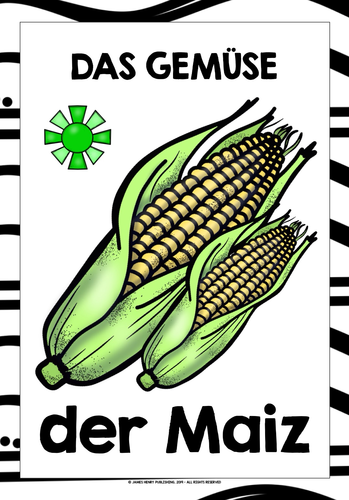



PRIMARY GERMAN KS3 GERMAN VEGETABLES POSTERS FLASHCARDS Das Gemüse auf Deutsch 25 vegetables in German, definite article, masculine & feminine, singular & plural. Using flashcards to introduce and practise language is a popular and successful language teaching and learning method, providing lots of opportunity for vocabulary games and recall. The flashcards are equally useful as classroom posters, keeping key target language prominent and visible, as well as creating a really German ambiance in the learning environment. I use this set to gradually introduce and work on the concept of gender, and to provide speaking and pronunciation prompts, from the straightforward Was ist das? to Ja/nein or Richtig/falsch questions, which allow us to move to from one-word responses to more complex language, such as plurals or particularly***negative sentences***, which can be quite tricky in German, and often requires a lot of practice Nein, das ist keine Karotte, das ist eine Kartoffel and so on. This kind of vocabulary is really useful for an implicit approach to introducing and practising the accusative of articles too, for example Ich habe einen Blumenkohl, ich habe den Blumenkohl.
The key focus on on the definite article, both masculine and feminine, singular and plural, though I do use the set to start to compare these with the indefinite article, which I’ve found to be a really successful way of helping students embed grammatical concepts such as gender, implicitly, without the need for repeated explicit instruction. It’s good to move away from predominantly teacher-led activities, and after the initial introduction phase, I have students take turns manipulating the cards and asking the questions. Again, this is a really popular activity, and a very easy way of enabling students to practise asking questions, instead of always responding to them.
The vegetables are:
artichoke
asparagus
beetroot
broccoli
cabbage
carrots
cauliflower
celery
corn
cucumber
eggplants/aubergines
French/green beans
garlic
leeks
lettuce
mushrooms
onions
peas
red peppers
yellow pepper
potatoes
sprouts
spinach
sweet potatoes
tomato
I don’t have 25 vegetables in my initial learning plan, but I always have additional language to provide some variety as well as a little extra challenge. This set includes some vegetables that children may not know yet, such as artichoke and asparagus, which gives us a chance to discuss healthy eating, vegetables we like, don’t like, or would like to try, and for generally developing children’s vocabulary in their own language too.
The product is non-editable in a zipped format. It is copyright, all rights reserved. It may not be copied, rewritten, shared or distributed, in whole or in part, outside your own classroom in any way. The license for purchase is a single-user license only. Please read the Terms of Use.
VIELEN DANK UND GUTEN APPETIT!
Something went wrong, please try again later.
This resource hasn't been reviewed yet
To ensure quality for our reviews, only customers who have purchased this resource can review it
Report this resourceto let us know if it violates our terms and conditions.
Our customer service team will review your report and will be in touch.